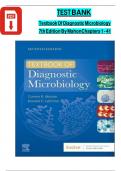TEST BANK j
j Textbook Of Diagnostic Microbiology
j j j j
j 7th Edition By MahonChapters 1 - 41
j j j j j j j
, Mahon: jTextbook2of jDiagnostic jMicrobiology, j7th jEdition jTest jBank
Table jof jcontents
Part j1: jIntroduction jto jClinical jMicrobiology
Chapter j 1. j Bacterial j Cell j Structure, j Physiology, j Metabolism, j and j Genetics
Chapter j 2. j Host-Parasite j Interaction
Chapter j 3. j The j Laboratory jRole j in j Infection j Control
Chapter j 4. j Control j of j Microorganisms: j Disinfection, j Sterilization, j and j Microbiology j Safety
Chapter j5. jPerformance jImprovement jin jthe jMicrobiology jLaboratory
Chapter j 6. j Specimen j Collection j and j Processing
Chapter j7. jMicroscopic2Examination jof jMaterials jfrom jInfected jSites
Chapter j8. j Use jof jColony jMorphology jfor jthe jPresumptive jIdentification jof jMicroorganisms
Chapter j9. j Biochemical jIdentification jof jGram-Negative jBacteria
Chapter j10. jImmunodiagnosis jof jInfectious jDiseases
Chapter j11. jApplications jof jMolecular jDiagnostics
Chapter j 12. j Antibacterial jMechanisms j of j Action j and j Bacterial j Resistance j Mechanisms
Chapter j13. jAntimicrobial jSusceptibility jTesting
Part j2: jLaboratory jIdentification jof jSignificant jIsolates
Chapter j14. jStaphylococci
Chapter j 15. j Streptococcus, j Enterococcus, j and j Other j Catalase-Negative, j Gram-Positive j Cocci
Chapter j16. jAerobic jGram-Positive jBacilli
Chapter j17. jNeisseria jSpecies jand jMoraxella jcatarrhalis
Chapter j 18. j Haemophilus, j HACEK, j Legionella j and j Other j Fastidious j Gram-Negative j Bacilli
Chapter j19. jEnterobacteriaceae
Chapter j20. jVibrio, jAeromonas, jand jCampylobacter jSpecies
Chapter j21. jNonfermenting jand jMiscellaneous2Gram-Negative jBacilli
Chapter j22. jAnaerobes jof jClinical jImportance
Chapter j 23. j The j Spirochetes
Chapter j 24. j Chlamydia, j Rickettsia, j and j Similar j Organisms
Chapter j25. jMycoplasma jand jUreaplasma
Chapter j 26. j Mycobacterium j tuberculosis j and j Nontuberculous j Mycobacteria
Chapter j27. jMedically jSignificant jFungi
Chapter j28. jDiagnostic jParasitology
Chapter j29. jClinical jVirology
Chapter j 30. j Agents j of j Bioterror j and j Forensic j Microbiology
Chapter j 31. j Biofilms: j Architects j of jDisease
Part j3: jLaboratory jDiagnosis jof jInfectious jDiseases: jand jOrgan jSystem jApproach jto jDiagnosticMicrobiology
Chapter j32. jUpper jand jLower jRespiratory jTract jInfections
Chapter j33. jSkin jand jSoft jTissue jInfections
Chapter j 34. j Gastrointestinal j Infections j and j Food j Poisoning
Chapter j 35. j Infections j of jthe j Central j Nervous j System
Chapter j36. jBacteremia jand jSepsis
Chapter j37. jUrinary jTract jInfections
Chapter j 38. j Genital j Infections j and j Sexually j Transmitted j Infections
Chapter j 39. j Infections jin jSpecial j Populations
Chapter j40. jZoonotic jDiseases
Chapter j41. jOcular jInfections
-
,Chapter j01: jBacterial jCell jStructure, jPhysiology, jMetabolism, jand jGeneticsMah
j on: jTextbook jof2Diagnostic jMicrobiology, j7th jEdition jTest jBank
MULTIPLE jCHOICE
1. To jsurvive, jmicrobial jinhabitants jhave jlearned jto jadapt jby jvarying jall jof jthe jfollowing, jexcept
a. growth jrate.
b. growth jin jall jatmospheric2conditions.
c. growth jat jparticular jtemperatures.
d. bacterial j shape.
ANS: jD
The jchapter jbegins jby jdiscussing jthe jway jmicrobial jinhabitants jhave jhad jto jevolve jto jsurvivein
jmany jdifferent jniches jand jhabitats. jIt jdiscusses jslow jgrowers, jrapid jgrowers, jand jreplication jwi
jth jscarce jor jabundant jnutrients, junder jdifferent jatmospheric jconditions, jtemperature jrequireme
j nts, jand jcell jstructure. jBacterial jshape jas ja jform jof jevolution jis jnot jdiscussed.
OBJ: jLevel j2: jInterpretation
2. Who jwas jconsidered jthe jfather jof jprotozoology jand jbacteriology?
a. Anton jvan jLeeuwenhoek
b. Louis jPasteur
c. Carl jLandsteiner
d. Michael j Douglas
ANS: jA
The jbook jdiscusses jAnton jvan jLeeuwenhoek jas jthe jinventor jof jthe jmicroscope jand jthe jfirst jperso jn
jto jsee jthe j―beasties.‖ jSo jthey jdubbed jhim jthe jfather jof jprotozoology jand jbacteriology.The jot
jher jthree jindividuals jwere jnot jdiscussed.
OBJ: j Level j1: jRecall
3. Prokaryotic jcells jhave jwhich jof jthe jfollowing jstructures jin jtheir jcytoplasm?
a. Golgi japparatus
b. Ribosomes
c. Mitochondria
d. Endoplasmic j reticulum
ANS: jB
All jthe jstructures jlisted jare jfound jin jeukaryotic jcells, jbut jribosomes jare jthe jonly jones jthatap
j ply jto jprokaryotic jcells.
OBJ: j Level j1: jRecall
4. This jform jof jDNA2is2commonly jfound jin jeukaryotic jcells.
a. Linear
b. Circular
c. Plasmid
d. Colloid
.
.
, ANS: jA
Circular jand jplasmid jDNA jare jusually jfound jonly jin jbacteria, jnot2eukaryotic jcells. jColloid jisa jpr
joperty jof jprotein jmolecules jand jis jnot2associated jwith jnucleotides.
OBJ: j Level j1: jRecall
5. The jnuclear jmembrane jin j prokaryotes j is
a. missing.
b. impenetrable.
c. a jclassic jmembrane.
d. a jlipid jbilayer jmembrane.
ANS: jA
Prokaryotic jcells jdo jnot jhave jany jmembrane-
bound jstructures jin jthe jcytoplasm jincluding jastructured jnucleus.
OBJ: j Level j1: jRecall
6. A jmicroorganism jthat jis ja junicellular jorganism jand jlacks ja jnuclear jmembrane jand jtruenu
j cleus jbelongs jto jwhich jclassification?
a. Fungi
b. Bacteria
c. Algae
d. Parasite
ANS: jB
Fungi, jalgae, jand jparasites jare junicellular jeukaryotic jorganisms jthat jcontain ja jtrue jnucleus.B
jacteria jare jprokaryotic jand jdo jnot jcontain ja jtrue jnucleus jor jnuclear jmembrane.
OBJ: j Level j1: jRecall
7. In j the j laboratory,2the j clinical j microbiologist j is j responsible j for j all j the j following, j except
a. isolating j microorganisms.
b. selecting jtreatment j for j patients.
c. identifying j microorganisms.
d. analyzing jbacteria jthat jcause jdisease.
ANS: jB
Clinical jmicrobiologists jdo jnot jselect jthe jtreatment jfor jpatients. jThey jprovide jthe jdoctor jwiththe
j name jof jthe jorganism jand jthe jantibiotics jthat jcan jkill jthe jbacteria, jbut jnot jin jthe jfinal jselection
jof jtreatment jprotocols.
OBJ: j Level j2: jRecall
8. What jenables2the jmicrobiologist jto jselect jthe jcorrect jmedia jfor jprimary jculture jand joptimizeth je
j chance jof jisolating ja jpathogenic jorganism?
a. Determining jstaining jcharacteristics
b. Understanding jthe j cell j structure jand j biochemical j pathways j of jan jorganism
c. Understanding jthe jgrowth jrequirements jof jpotential jpathogens jat jspecific jbody jsite
d. Knowing jthe j differences j in j cell j walls j of jparticular j bacteria
ANS: jC




